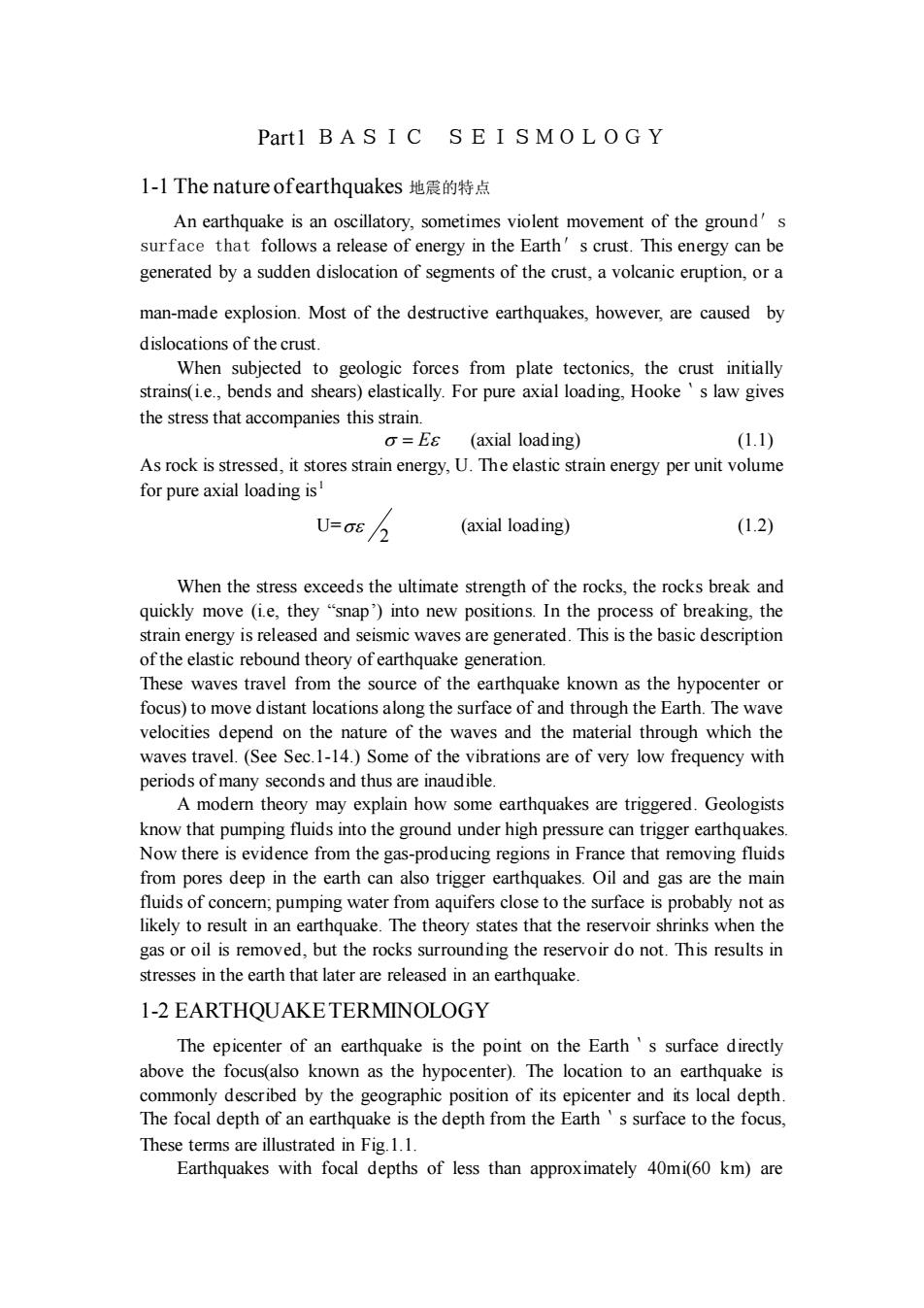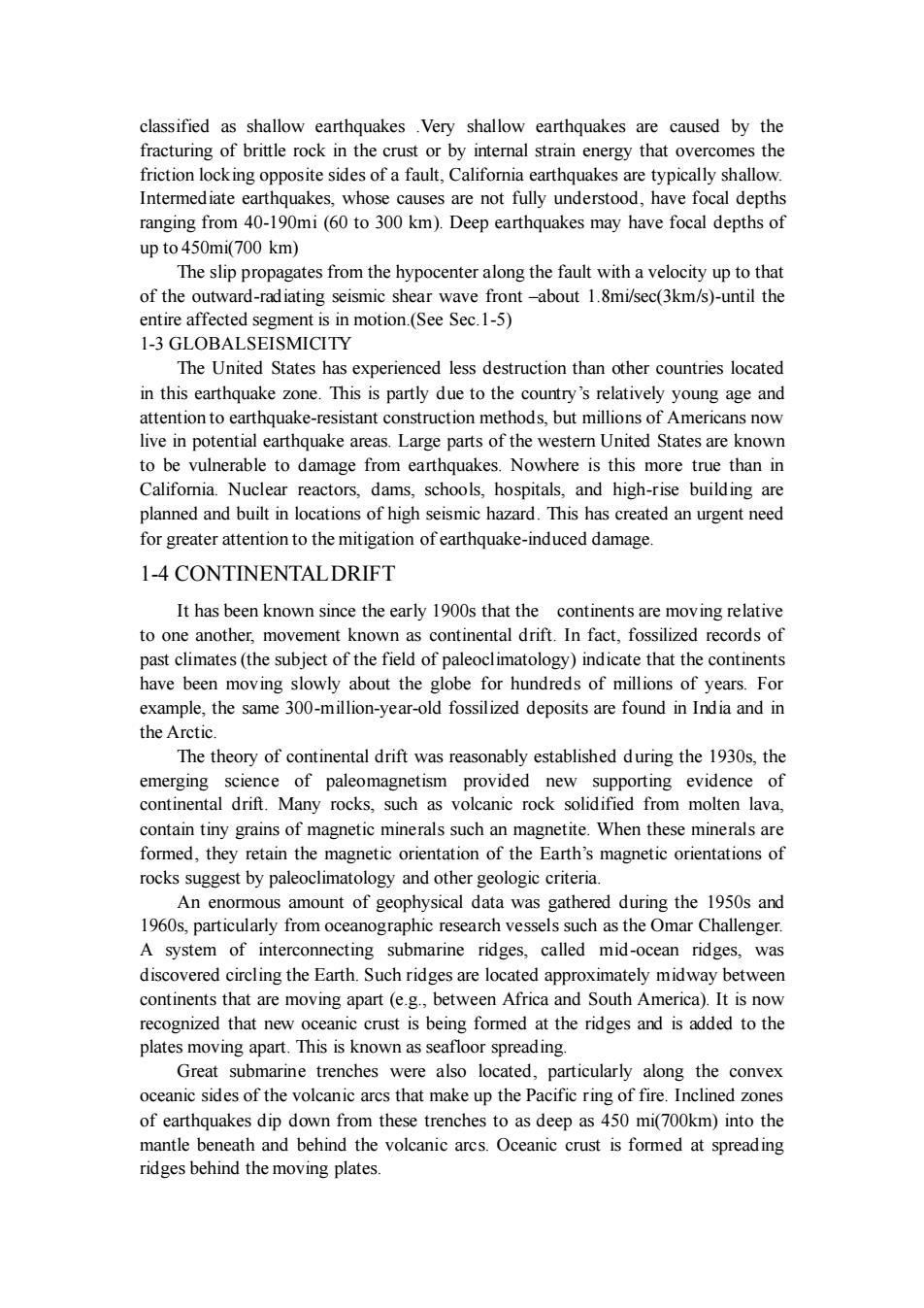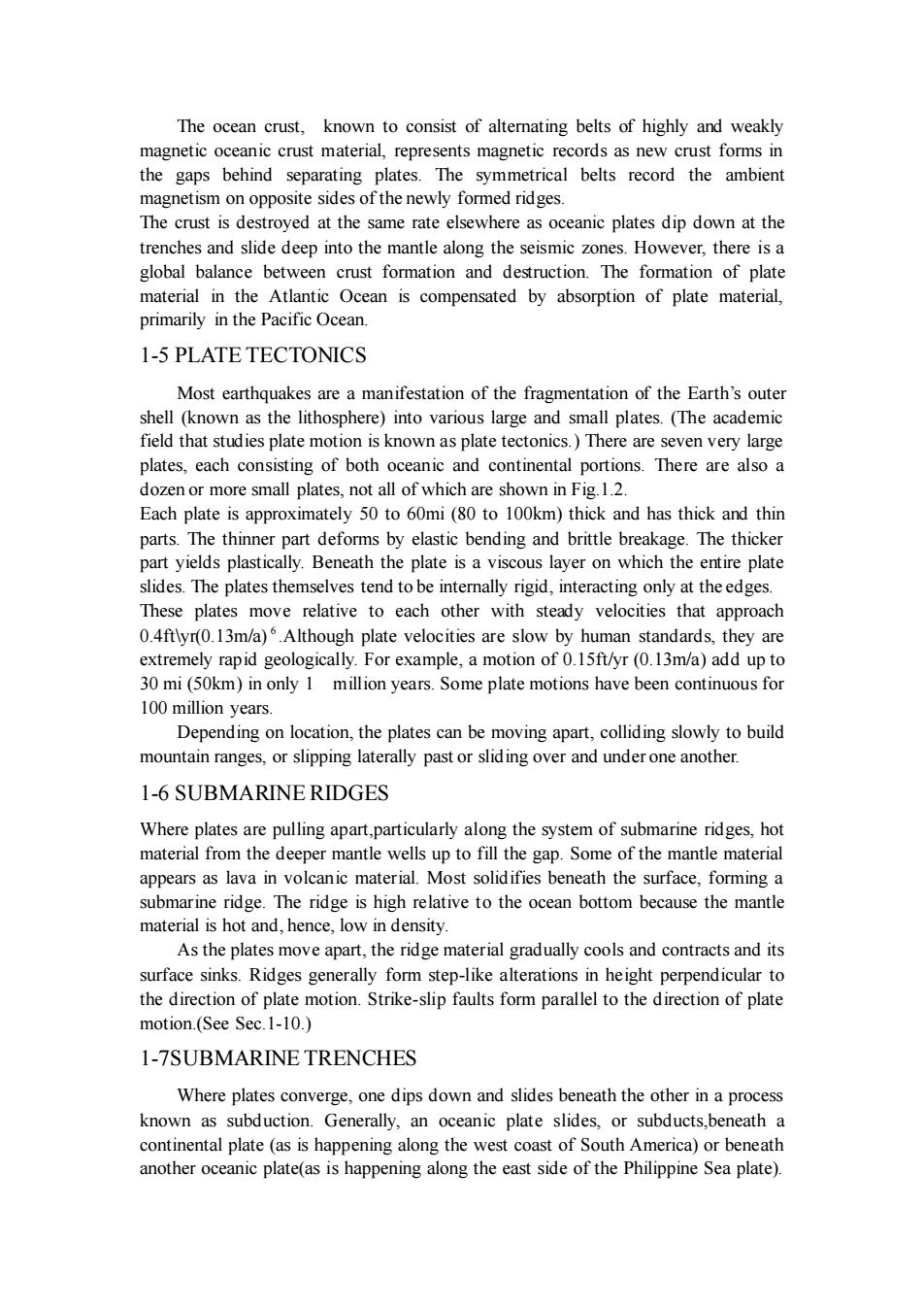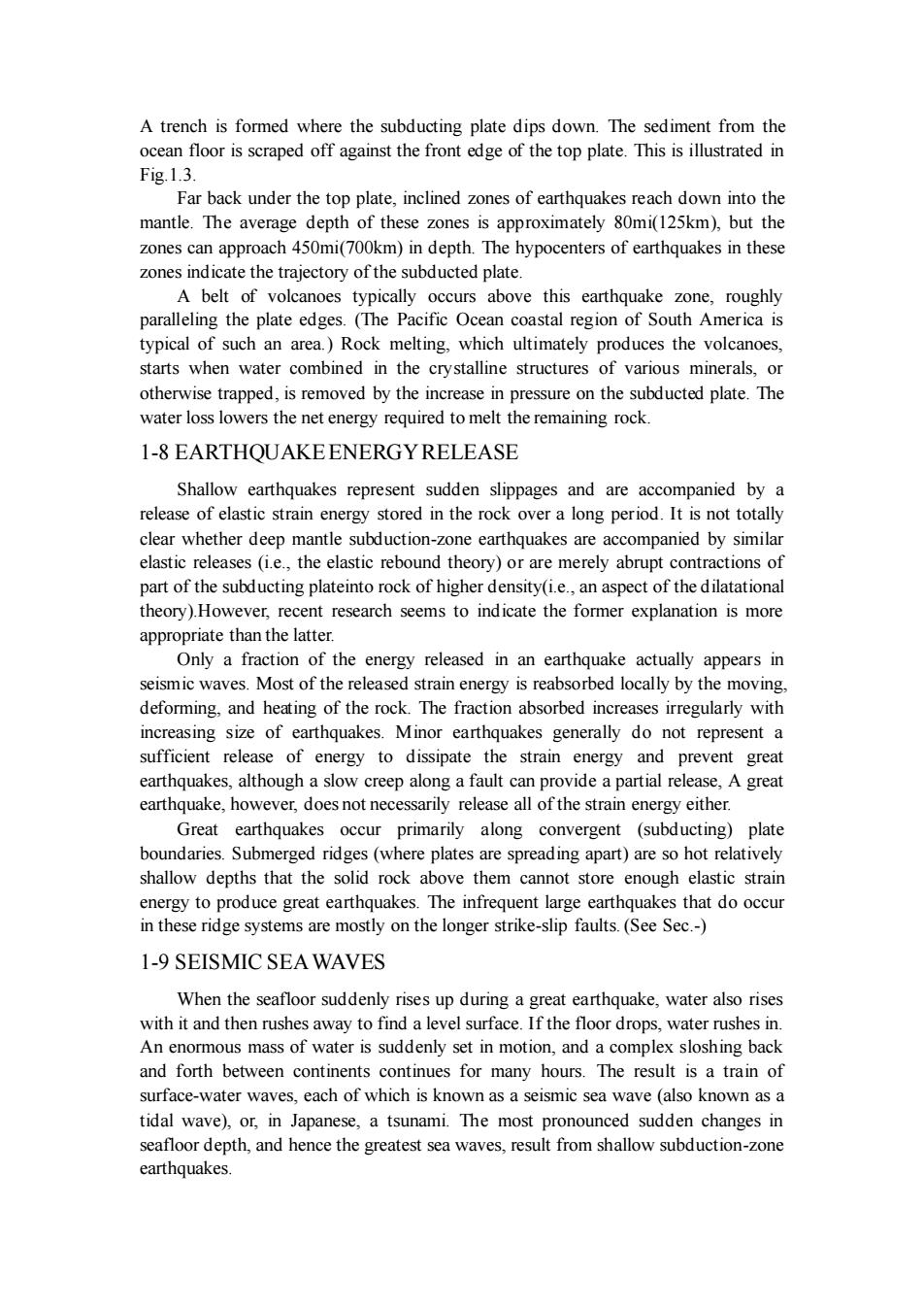
Seismic Design of Building Structures
Seismic Design of Building Structures

Part1 BAS I C S E I S MOL OGY l-1 The nature ofearthquakes地震的特点 An earthquake is an oscillatory,sometimes violent movement of the ground's surface that follows a release of energy in the Earth's crust.This energy can be generated by a sudden dislocation of segments of the crust,a volcanic eruption,ora man-made explosion.Most of the destructive earthquakes,however,are caused by dislocations of the crust. When subjected to geologic forces from plate tectonics,the crust initially strains(ie bends and shears)elastically.For pure axial loading,Hooke's law gives the stress that accompanies this strain. 0=Es (axial loading) (1.1) As rock is stressed,it stores strain energy,U.The elastic strain energy per unit volume for pure axial loading is U=GE 2 (axial loading) (12) When the stress exceeds the ultimate strength of the rocks,the rocks break and quickly move (i.e,they "snap')into new positions.In the process of breaking,the strain energy is released and seismic waves are generated.This is the basic description of the elasti rebound theory of earthqu gener These waves travel from the source of the earthquake known as the hypocenter or focus)to move distant locations along the surface of and through the Earth.The wave velocities depend on the nature of the waves and the material through which the waves travel.(See Sec.1-14.)Some of the vibrations are of very low frequency with periods ofm ny onds and thus are inaudible A modern theory may explain how some earthquakes are triggered.Geologists know that pumping fluids into the ground under high pressure can trigger earthquakes Now there is evidence from the gas-producing regions in France that removing fluids from pores deep in the earth can also trigger earthquakes.Oil and gas are the main fluids of concem;pumping water from aquifers close to the surface is probably not as likely to result in ar quake.The theory states that the the gas or oil is removed,but the rocks surrounding the reservoir do not.This results in stresses in the earth that later are released in an earthquake. 1-2 EARTHQUAKETERMINOLOGY The epicenter of an earthquake is the point on the Earth's surface directly above the focus(also known as the hypocenter).The location to an earthquake is commonly described by the geographic position of its epicenter and its local depth. The focal depth of an earthquake is the depth from the Earth's surface to the focus. These terms are illustrated in Fig.1.1. Earthquakes with focal depths of less than approximately 40mi(60 km)are
Part1 BASIC SEISMOLOGY 1-1 The nature of earthquakes 地震的特点 An earthquake is an oscillatory, sometimes violent movement of the ground′s surface that follows a release of energy in the Earth′s crust. This energy can be generated by a sudden dislocation of segments of the crust, a volcanic eruption, or a man-made explosion. Most of the destructive earthquakes, however, are caused by dislocations of the crust. When subjected to geologic forces from plate tectonics, the crust initially strains(i.e., bends and shears) elastically. For pure axial loading, Hooke‵s law gives the stress that accompanies this strain. = E (axial loading) (1.1) As rock is stressed, it stores strain energy, U. The elastic strain energy per unit volume for pure axial loading is 1 U= 2 (axial loading) (1.2) When the stress exceeds the ultimate strength of the rocks, the rocks break and quickly move (i.e, they “snap’) into new positions. In the process of breaking, the strain energy is released and seismic waves are generated. This is the basic description of the elastic rebound theory of earthquake generation. These waves travel from the source of the earthquake known as the hypocenter or focus) to move distant locations along the surface of and through the Earth. The wave velocities depend on the nature of the waves and the material through which the waves travel. (See Sec.1-14.) Some of the vibrations are of very low frequency with periods of many seconds and thus are inaudible. A modern theory may explain how some earthquakes are triggered. Geologists know that pumping fluids into the ground under high pressure can trigger earthquakes. Now there is evidence from the gas-producing regions in France that removing fluids from pores deep in the earth can also trigger earthquakes. Oil and gas are the main fluids of concern; pumping water from aquifers close to the surface is probably not as likely to result in an earthquake. The theory states that the reservoir shrinks when the gas or oil is removed, but the rocks surrounding the reservoir do not. This results in stresses in the earth that later are released in an earthquake. 1-2 EARTHQUAKE TERMINOLOGY The epicenter of an earthquake is the point on the Earth‵s surface directly above the focus(also known as the hypocenter). The location to an earthquake is commonly described by the geographic position of its epicenter and its local depth. The focal depth of an earthquake is the depth from the Earth‵s surface to the focus, These terms are illustrated in Fig.1.1. Earthquakes with focal depths of less than approximately 40mi(60 km) are

classified as shallow earthauakes very shallow earthauakes are caused by the fracturing of brittle rock in the cru teral strain energy that overcom s the aearthquakes are typically shallow Intermediate earthquakes,whose causes are not fully understood,have focal depths ranging from 40-190mi(60 to 300 km).Deep earthquakes may have focal depths of up to 450mi(700 km) The slip eates from the hypocenter along the fault with a velocity y up to that -rad iating seismic shea ar wave fro nt-about 1.8mi/sec(3km/s)-until the entire affected segment is in motion.(See Sec.1-5) 1-3 GLOBALSEISMICITY The United States has experienced less destruction than other countries located in this carthounke on Ts s pak dne to the young age and attention to earthquak e-resistant construction met ut millio Am cans nov live in potentia l earthquake areas.Large parts of the western United States are known to be vulnerable to damage from earthquakes.Nowhere is this more true than in Califomia.Nuclear reactors,dams,schools,hospitals,and high-rise building are planned and built in locations of high seismic hazard.This has created an urgent need for greater attention to the mitigation of earthquake-induced damage 1-4 CONTINENTALDRIFT It has been known since the early 1900s that the continents are moving relative to one another,movement known as continental drift.In fact,fossilized records of past climates(the subject of the field of paleoclimatology)indicate that the continents have been moving s about the nhe r hundreds nillions of years example,the same 300-million-year-old fossilized deposits are found in India and in the Arctic. The theory of continental drift was reasonably established during the 1930s.the emerging science of paleomagnetism provided new supporting evidence of contine tal drift.Many ro ks lcanic rock solidified fro ten lava contain tiny grains of magnetic minerals such an magnetite.When these minerals are formed.they retain the magnetic orientation of the Earth's magnetic orientations of rocks suggest by paleoclimatology and other geologic criteria. An enormous amount of geophysical data was gathered during the 1950s and 1960s,particularly from oceanog aphic research vessels such as the Omar Challenger. A system of i interconnecting submarine ridges.called mid- ocean ridges,was discovered circling the Earth.Such ridges are located approximately midway between continents that are moving apart (e.g.,between Africa and South America).It is now recognized that new oceanic crust is being formed at the ridges and is added to the plates moving apart.This is known as seafloor spreading Grea e trenches ere also locat particularly along oceanic sides of the volcanic arcs that make up the Pacific ring of fire.Inclined zones of earthquakes dip down from these trenches to as deep as 450 mi(700km)into the mantle beneath and behind the volcanic arcs.Oceanic crust is formed at spreading ridges behind the moving plates
classified as shallow earthquakes .Very shallow earthquakes are caused by the fracturing of brittle rock in the crust or by internal strain energy that overcomes the friction locking opposite sides of a fault, California earthquakes are typically shallow. Intermediate earthquakes, whose causes are not fully understood, have focal depths ranging from 40-190mi (60 to 300 km). Deep earthquakes may have focal depths of up to 450mi(700 km) The slip propagates from the hypocenter along the fault with a velocity up to that of the outward-radiating seismic shear wave front –about 1.8mi/sec(3km/s)-until the entire affected segment is in motion.(See Sec.1-5) 1-3 GLOBALSEISMICITY The United States has experienced less destruction than other countries located in this earthquake zone. This is partly due to the country’s relatively young age and attention to earthquake-resistant construction methods, but millions of Americans now live in potential earthquake areas. Large parts of the western United States are known to be vulnerable to damage from earthquakes. Nowhere is this more true than in California. Nuclear reactors, dams, schools, hospitals, and high-rise building are planned and built in locations of high seismic hazard. This has created an urgent need for greater attention to the mitigation of earthquake-induced damage. 1-4 CONTINENTAL DRIFT It has been known since the early 1900s that the continents are moving relative to one another, movement known as continental drift. In fact, fossilized records of past climates (the subject of the field of paleoclimatology) indicate that the continents have been moving slowly about the globe for hundreds of millions of years. For example, the same 300-million-year-old fossilized deposits are found in India and in the Arctic. The theory of continental drift was reasonably established during the 1930s, the emerging science of paleomagnetism provided new supporting evidence of continental drift. Many rocks, such as volcanic rock solidified from molten lava, contain tiny grains of magnetic minerals such an magnetite. When these minerals are formed, they retain the magnetic orientation of the Earth’s magnetic orientations of rocks suggest by paleoclimatology and other geologic criteria. An enormous amount of geophysical data was gathered during the 1950s and 1960s, particularly from oceanographic research vessels such as the Omar Challenger. A system of interconnecting submarine ridges, called mid-ocean ridges, was discovered circling the Earth. Such ridges are located approximately midway between continents that are moving apart (e.g., between Africa and South America). It is now recognized that new oceanic crust is being formed at the ridges and is added to the plates moving apart. This is known as seafloor spreading. Great submarine trenches were also located, particularly along the convex oceanic sides of the volcanic arcs that make up the Pacific ring of fire. Inclined zones of earthquakes dip down from these trenches to as deep as 450 mi(700km) into the mantle beneath and behind the volcanic arcs. Oceanic crust is formed at spreading ridges behind the moving plates

The ocean crust,known to consist of altemating belts of highly and weakly magnetic oceanic crust material,represents magnetic records as new cr st forms in the gaps behind separating plates.The symmetrical belts record the ambient magnetism on opposite sides of the newly formed ridges. The crust is destroyed at the same rate elsewhere as oceanic plates dip down at the trenches and slide deep into the mantle along the seismic zones.However,there is a global balance between crust formation and destruction.The formation of plat material in the Atlantic Ocean is compensated by absorption of plate material, primarily in the Pacific Ocean. 1-5 PLATE TECTONICS Most earthquakes are manifestation of the fragmentation of the Earth's oute shell (known as the lithosph ere)into various large and sma I plates (The academic field that studies plate motion is known as plate tectonics.)There are seven very large plates,each consisting of both oceanic and continental portions.There are also a dozen or more small plates,not all of which are shown in Fig.1.2. Each plate is approximately 50 to 60mi(8 to 100km)thick and has thick and thin parts e thi by elastic bending and brittle b The thick part yields plastically.Beneath the plate is a viscous layer on which the entire plate slides.The plates themselves tend to be interally rigid,interacting only at the edges. These plates move relative to each other with steady velocities that approach 0.4ftlyr(0.13m/a)Although plate velocities are slow by human standards,they are rapi geological 30 mi(50km)in only or example,a m on of 0.15ft/yr(0.13m/a)ad d up million years.Some plate motions have been continuous for 100 million years. Depending on location,the plates can be moving apart,colliding slowly to build mountain ranges,or slipping laterally past or sliding over and underone another. 1-6 SUBMARINE RIDGES Where plates are pulling apart,particularly along the system of submarine ridges,hot material from the deeper mantle wells up to fill the gap.Some of the mantle material appears as lava in volcanic material.Most solidifies beneath the surface,forming a submarine ridge.The ridge is high relative to the ocean bottom because the mantle mate erial is ho and.hence low in density As the plates move apart,the ridge material gradually cools and contracts and its surface sinks.Ridges generally form step-like alterations in height perpendicular to the direction of plate motion.Strike-slip faults form parallel to the direction of plate motion.(See Sec.1-10.) 1-7SUBMARINE TRENCHES Where plates converge,one dips down and slides beneath the other in a process known as subduction.Generally,an oceanic plate slides,or subducts,beneath a continental plate (as is happening along the west coast of South America)or beneath another oceanic plate(as is happening along the east side of the Philippine Sea plate)
The ocean crust, known to consist of alternating belts of highly and weakly magnetic oceanic crust material, represents magnetic records as new crust forms in the gaps behind separating plates. The symmetrical belts record the ambient magnetism on opposite sides of the newly formed ridges. The crust is destroyed at the same rate elsewhere as oceanic plates dip down at the trenches and slide deep into the mantle along the seismic zones. However, there is a global balance between crust formation and destruction. The formation of plate material in the Atlantic Ocean is compensated by absorption of plate material, primarily in the Pacific Ocean. 1-5 PLATE TECTONICS Most earthquakes are a manifestation of the fragmentation of the Earth’s outer shell (known as the lithosphere) into various large and small plates. (The academic field that studies plate motion is known as plate tectonics.) There are seven very large plates, each consisting of both oceanic and continental portions. There are also a dozen or more small plates, not all of which are shown in Fig.1.2. Each plate is approximately 50 to 60mi (80 to 100km) thick and has thick and thin parts. The thinner part deforms by elastic bending and brittle breakage. The thicker part yields plastically. Beneath the plate is a viscous layer on which the entire plate slides. The plates themselves tend to be internally rigid, interacting only at the edges. These plates move relative to each other with steady velocities that approach 0.4ft\yr(0.13m/a) 6 .Although plate velocities are slow by human standards, they are extremely rapid geologically. For example, a motion of 0.15ft/yr (0.13m/a) add up to 30 mi (50km) in only 1 million years. Some plate motions have been continuous for 100 million years. Depending on location, the plates can be moving apart, colliding slowly to build mountain ranges, or slipping laterally past or sliding over and under one another. 1-6 SUBMARINE RIDGES Where plates are pulling apart,particularly along the system of submarine ridges, hot material from the deeper mantle wells up to fill the gap. Some of the mantle material appears as lava in volcanic material. Most solidifies beneath the surface, forming a submarine ridge. The ridge is high relative to the ocean bottom because the mantle material is hot and, hence, low in density. As the plates move apart, the ridge material gradually cools and contracts and its surface sinks. Ridges generally form step-like alterations in height perpendicular to the direction of plate motion. Strike-slip faults form parallel to the direction of plate motion.(See Sec.1-10.) 1-7SUBMARINE TRENCHES Where plates converge, one dips down and slides beneath the other in a process known as subduction. Generally, an oceanic plate slides, or subducts,beneath a continental plate (as is happening along the west coast of South America) or beneath another oceanic plate(as is happening along the east side of the Philippine Sea plate)

a trench is formed where the subducting plate dins down The sediment from the floor is scraped off against the front edge of the top plate.This is illustrated in Fig.1. Far back under the top plate,inclined zones of earthquakes reach down into the mantle.The average depth of these zones is approximately 80mi(125km),but the zones can approach 450mi(700km)in depth.The hypocenters of earthquakes in these zones indic e the trajectory of the subducted plate belt olcanoes typicall occurs s above this earthquake one,roughly paralleling the plate edges.(The Pacific Ocean coastal region of South America is typical of such an area.)Rock melting.which ultimately produces the volcanoes, starts when water combined in the crystalline structures of various minerals,or otherwise trapped,is removed by the increase in pressure on the subducted plate.The water loss lowers the net energy required to melt the remaining rock 1-8 EARTHQUAKEENERGY RELEASE Shallow earthquakes represent sudden slippages and are accompanied by a release of elastic strain energy stored in the rock over a long period.It is not totally p mantle ompanied by releas s(ie.the elastic rebound theory)or are merely abrupt part of the subducting plateinto rock of higher density(ie.an aspect of the dilatational theory).However,recent research seems to indicate the former explanation is more appropriate than the latter Only a fraction of the energy released in an earthauake actually appears in seismic waves Most of the release train energy is orbed locally by the moving. deforming,and heating of the rock.The fraction absorbed increases irregularly with increasing size of earthquakes.Minor earthquakes generally do not represent a sufficient release of energy to dissipate the strain energy and prevent great earthquakes,although a slow creep along a fault can provide a partial release,A great earthquake.h does ot n ssarily rel ase all of the stra y either Great earthquakes occur primarily along convergent (subducting)plate boundaries.Submerged ridges (where plates are spreading apart)are so hot relatively shallow depths that the solid rock above them cannot store enough elastic strain energy to produce great earthquakes.The infrequent large earthquakes that do occur in these ridge systems are mostly on the longer strike-slip faults.(See Sec.-) 1-9 SEISMIC SEA WAVES When the seafloor suddenly rises up during a great earthquake,water also rises with it and then rushes away to find a level surface.If the floor drops,water rushes in. An enormous mass of water is suddenly set in motion,and a complex sloshing back and forth between cor for many ours.The resu It is s a train of surface-water waves,each of which is known as a seismic sea wave(also known as a tidal wave),or,in Japanese,a tsunami.The most pronounced sudden changes in seafloor depth,and hence the greatest sea waves,result from shallow subduction-zone earthquakes
A trench is formed where the subducting plate dips down. The sediment from the ocean floor is scraped off against the front edge of the top plate. This is illustrated in Fig.1.3. Far back under the top plate, inclined zones of earthquakes reach down into the mantle. The average depth of these zones is approximately 80mi(125km), but the zones can approach 450mi(700km) in depth. The hypocenters of earthquakes in these zones indicate the trajectory of the subducted plate. A belt of volcanoes typically occurs above this earthquake zone, roughly paralleling the plate edges. (The Pacific Ocean coastal region of South America is typical of such an area.) Rock melting, which ultimately produces the volcanoes, starts when water combined in the crystalline structures of various minerals, or otherwise trapped, is removed by the increase in pressure on the subducted plate. The water loss lowers the net energy required to melt the remaining rock. 1-8 EARTHQUAKE ENERGY RELEASE Shallow earthquakes represent sudden slippages and are accompanied by a release of elastic strain energy stored in the rock over a long period. It is not totally clear whether deep mantle subduction-zone earthquakes are accompanied by similar elastic releases (i.e., the elastic rebound theory) or are merely abrupt contractions of part of the subducting plateinto rock of higher density(i.e., an aspect of the dilatational theory).However, recent research seems to indicate the former explanation is more appropriate than the latter. Only a fraction of the energy released in an earthquake actually appears in seismic waves. Most of the released strain energy is reabsorbed locally by the moving, deforming, and heating of the rock. The fraction absorbed increases irregularly with increasing size of earthquakes. Minor earthquakes generally do not represent a sufficient release of energy to dissipate the strain energy and prevent great earthquakes, although a slow creep along a fault can provide a partial release, A great earthquake, however, does not necessarily release all of the strain energy either. Great earthquakes occur primarily along convergent (subducting) plate boundaries. Submerged ridges (where plates are spreading apart) are so hot relatively shallow depths that the solid rock above them cannot store enough elastic strain energy to produce great earthquakes. The infrequent large earthquakes that do occur in these ridge systems are mostly on the longer strike-slip faults. (See Sec.-) 1-9 SEISMIC SEA WAVES When the seafloor suddenly rises up during a great earthquake, water also rises with it and then rushes away to find a level surface. If the floor drops, water rushes in. An enormous mass of water is suddenly set in motion, and a complex sloshing back and forth between continents continues for many hours. The result is a train of surface-water waves, each of which is known as a seismic sea wave (also known as a tidal wave), or, in Japanese, a tsunami. The most pronounced sudden changes in seafloor depth, and hence the greatest sea waves, result from shallow subduction-zone earthquakes